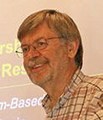“It has taken more than a decade to implement a policy, program and regulatory framework that makes ‘Water-Resilient Communities’ possible in British Columbia,” Kim Stephens explained to a local government audience in Parksville

“Kim Stephens was able to communicate concepts in a way that made sense to the class. They understood him perfectly,” observed Todd Pugh, sessional instructor for Capilano’s Local Government Administration Certificate program. “It is such a mix of people – there were some who would have liked to hear more about the science behind what he presented, and for others it was more science than they’ve experienced since elementary school. So on the whole, I think he hit the right mix.”





